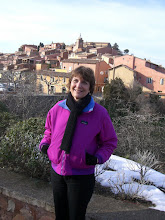
Since we had spent a year in France’s third-largest city at the beginning of the 1990s with our two sons, we always feel a special connection with
Lyon and try to get back for a visit every once in awhile. Part of our itinerary necessarily includes a walk past where we used to live in
le sixième arrondissement ("the sixth district"), the boys’ former school, and the little park down
rue Bossuet where they liked to play in the evenings. Obviously, many things in our old neighborhood have changed: the little
Prety grocery store is gone, our former local
boulangerie is no longer called
Au Feu du Bois, and the big
supermarché ATAC has been bought out by the oddly-named chain
Simply Market. (Come to think of it, ATAC wasn't your run of the mill name for a supermarket either!) But other past “favorites” remain. The two
chocolatiers on
Cours Franklin Roosevelt,
Bernachon and
Tourtiller, are still going strong although the second shop has been sold and will soon have a new name.
One thing you notice right away about Lyon is how prosperous the city looks. Well-dressed citizens, beautiful architecture, shops selling fur coats, Dior clothing, Cartier jewelry, or Louis Vuitton luggage. What we didn’t realize is that Lyon has been an affluent area for centuries. The
Office du tourisme, located in the city center on
Place Bellecour, offered a nine-euro

visit of
le vieux Lyon Renaissance that we took advantage of last Thursday. One of our first stops was to see
la Cathédrale Saint Jean and its fourteenth century
horloge astronomique. This famous clock tells not only the time, but shows the season, the zodiac sign, and the yearly and ecclesiastical calendar; a mechanism adding the minutes was inserted in the 1600s. At 2:59 we watched as the angel on the left began the process by turning
un sablier (“an hourglass”) back and forth in his hand.
L’ange Gabriel then came out on the right to announce to Mary that she was to be the mother of Jesus, while
Dieu le père (“God the Father”), dressed in red, nodded his approval from up above, just before the clock chimed three times. Our tour guide, an Austrian woman named Anneliese, pointed out that not many cities could afford such a device. Wealth came early to Lyon mainly by way of
des foires (“fairs”) which brought 4,000 to 6,000 vendors from all over Europe several times a year to sell everything from textiles to spices. This led to the development of banking and printing industries in the city.

Along with an increase in riches came a corresponding increase in population. Our tour then concentrated on the well-known
cours intérieures (“inner courtyards”),
escaliers à vis (“spiral staircases”), and
loges that were built to accommodate all of the people in the old part of the city. Apparently several twentieth century mayors wanted to raze
le vieux Lyon in favor of more modern housing but were stopped by resident associations and author André Malraux, who served as
ministre des Affaires Culturelles in the early 1960s. We also traveled through
des traboules (from the Italian
transambulare, “to travel across”), long passageways which enabled inhabitants to go from one street to another and served to hide people familiar with the system during the German Occupation in World War II.
 La fête du travail
La fête du travail, held every May 1st, is a national holiday, the equivalent of Labor Day in the United States. Great for all workers, not so great for travelers since there is no public transportation and not many businesses are open. Lucky for us, however, Lyon has a spacious and beautiful park,
le Parc de la Tête d’or (so named because of a legend involving the buried statue of a golden head of Christ, which has never been found). We had a lovely day walking around the zoo, the lake, and flower gardens, as well as having lunch in one of the outdoor cafés on the property. All in all, it was a wonderful visit to Lyon, whose new motto "Only Lyon" is a play on the letters of its name.

 translated in February, we took le métro back to the 14e where our hotel is located. From the subway station we walked through the beautiful alleys of le cimetière Montparnasse. A small crowd was gathered at the tomb of Sartre and Beauvoir; some ladies were filling up watering cans for the plants on their family’s graves. We spent a little time on this lovely day wandering around looking for the gravesites of famous people like singer Serge Gainsbourg and authors Maupassant and Baudelaire. Paris has so much to offer and we'll be out exploring for several days to come.
translated in February, we took le métro back to the 14e where our hotel is located. From the subway station we walked through the beautiful alleys of le cimetière Montparnasse. A small crowd was gathered at the tomb of Sartre and Beauvoir; some ladies were filling up watering cans for the plants on their family’s graves. We spent a little time on this lovely day wandering around looking for the gravesites of famous people like singer Serge Gainsbourg and authors Maupassant and Baudelaire. Paris has so much to offer and we'll be out exploring for several days to come.




























